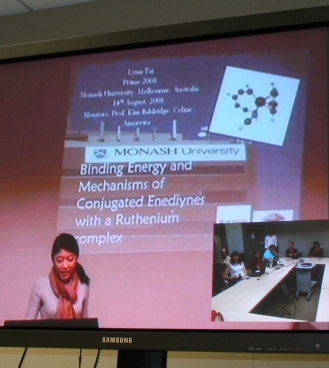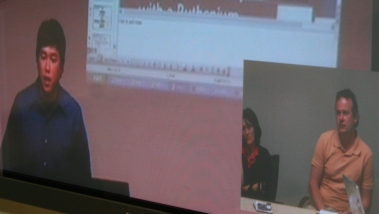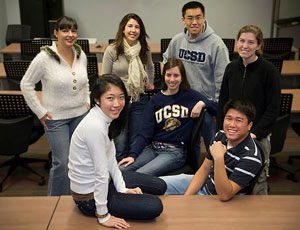PRIME Students Make Face-to-Face Presentations From Across the Globe
By Maureen C. Curran
|
San Diego, CA, August 27, 2008 -- The PRIME 2008 students who have been working at Monash University in Australia this summer had the unique opportunity of giving final presentations simultaneously to their mentors on both sides of the globe last week via high definition streaming video back to UCSD.
It was 10 a.m. Wednesday, August 20, in Melbourne, Australia and 5 p.m. the day before (Tuesday, August 19) in San Diego, when David Abramson, a computer scientist at Monash University and director of Monash's eScience and Grid Engineering Lab, opened the session.
The students made their presentations via live streaming video feed from Melbourne to a conference room in Atkinson Hall. The students and audience at Monash were able to see and talk with the UCSD mentors and PRIME program people in real time.
"This is the first time the PRIME program has done this," said Peter Arzberger, a PRIME program co-investigator, before the event. "It is an experiment in two senses," he continued, "It uses the growing capability of technology around the world and it engages the UCSD mentors in the final presentations." Arzberger is a long-time Calit2-affiliated researcher.
|
"I like the presentations very much and having them in one time frame was great," said Jürgen Schulze, a Calit2 project scientist, "And the technology worked flawlessly."
Schulze added "The presentations also provided a quick summary of all of the projects, which helps to identify overlaps and possible future projects." Sirvard Nshanyan, a computer science and engineering major, was Schulze's first student to work in Australia. He had previously mentored students working at other PRIME host locations.
Gabriele Wienhausen, the principal investigator of PRIME, was also pleased. "This was fun, very nice," she said, "Having presentations in this manner really helps us to build the community that needs to be created. It is part of being able to have a highly distributed program while still feeling connected." Wienhausen is the associate dean of education for the UCSD Division of Biological Sciences.
The Pacific Rim Experiences for Undergraduates (PRIME) program provides undergraduates with the opportunity of doing real research while living for nine weeks in one of several Pacific Rim countries, working with mentors at both the host institution and at UCSD. "We are immersing the students in both scientific research and a new culture by providing them with experiential training in both the conduct of research and in the international global workplace," noted Wienhausen.
|
PRIME students build collaborations between their host and UCSD mentors. "This has definitely been the best summer I have ever experienced! It was nice to collaborate with researchers at UCSD and at Monash," said Arielle Yablonovitch, a Physics major, "It was sometimes a challenge because my mentors had very different research and educational backgrounds, but I'm glad that I was able to get feedback from two different perspectives."
"This is the fifth year my research group has sent PRIME students to Melbourne," explained Andrew McCulloch a professor and the chair of UCSD's Department of Bioengineering, "Thanks to the progress we made in previous years working with David Abramson's group and with the mentoring by research scientists Anushka Michailova and Roy Kerckhoffs, the UCSD students at Monash University this year were able to achieve far more in just a few short weeks than we would even have dreamed of five years ago." McCulloch is the head of the UCSD Bioengineering department's Cardiac Mechanics Research Group.
Seven students were mentored by Abramson in his lab at Monash University's Faculty of Information Technology. They presented the results of their summer's work in areas of visualization, human biology (in particular, the heart), bioengineering and other topics. (A list of students and their projects can be found at the end of this story.) All of them used the cyberinfrastructure of the Pacific Rim Applications and Grid Middleware Assembly (PRAGMA) grid and most used Nimrod, a parametric modeling system developed at Monash. This software tool enables users to harness multiple, distributed computers (such as a grid) for large-scale simulations. Arzberger is the principal investigator of PRAGMA, a group of leading Pacific Rim research organizations collaborating on advancing grid technology applications. The majority of the host institutions are members of PRAGMA.
|
"I like the idea of having students present their research," Calit2's Schulze noted, "because it serves as a milestone which makes them reflect on what they have actually accomplished."
"My fellow PRIME students should all feel very proud," said Haley Hunter-Zinck, a bioengineering/bioinformatics major, "Seeing everyone's presentation was a heart-warming experience because the presentations allowed us to concentrate on what we had accomplished and not the many trials and errors we faced over the summer."
The strong ongoing collaboration between Monash's eScience and Grid Engineering Lab and UCSD's Cardiac Mechanics Research Group headed by Abramson and McCulloch, respectively, is one of the beacons of success for PRIME. "Monash University's vice-chancellor of International Affairs likes the program so much," announced Arzberger "that with a request from David Abramson, she funded a prototype of PRIME -- the Monash University Research Program Abroad (MURPA). UCSD will be receiving some students in January 2009!" PRIME also has a similarly long-lived strong relationship with another host institution, Osaka University, which began a program, the Pacific Rim International UniverSities (PRIUS), modeled on PRIME last year, albeit for graduate students.
In addition to Wienhausen, McCulloch, Kerckhoffs, Michailova and Schulze, other UCSD mentors in attendance included San Diego Supercomputer Center (SDSC) researchers Ilkay Altintas, Mason Katz, Lei Xie and Cindy Zheng and PRIME program manager Teri Simas. This was the fifth year of the PRIME program, which is funded by the National Science Foundation (NSF, INT 0407508), with additional support from Calit2, the National Biomedical Computation Resource, and the Telemedicine and Advanced Technology Research Center.
|
|
Related Links
PRIME
PRIME 2008 Students
PRAGMA
National Biomedical Computation Resource
Telemedicine and Advanced Technology Research Center
Related Articles
Summer Is PRIME Time for UC San Diego Undergraduates Around Pacific Rim






